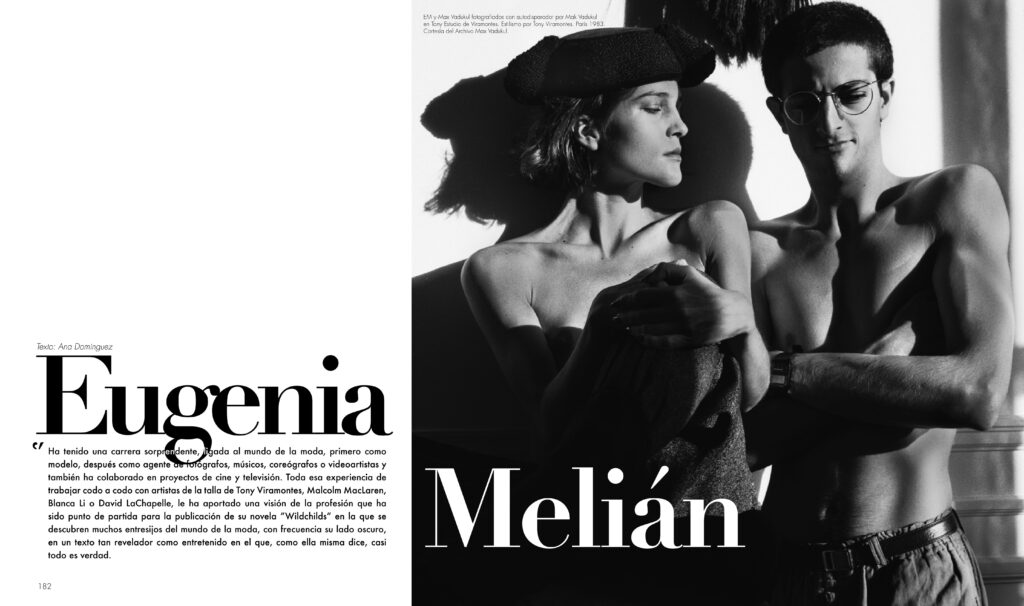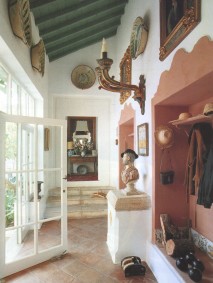Life Fully
Eugenia Melian in conversations with Ana Dominguez Siemens for White Paper By
She has had an amazing career, linked to the world of fashion, first as a model, then as an agent and producer for photographers, musicians, choreographers or video artists, and has also collaborated on film and television projects. All that experience of working side by side with artists of the stature of Tony Viramontes, Malcolm McLaren, Matthew Herbert, Blanca Li or David LaChapelle, has given her a vision of the profession that has been the starting point for the publication of her novel Wildchilds in which one will discover the inner workings of the world of fashion and its often dark side, in a text as revealing as it is entertaining, and in which, as she herself says, almost everything is true.
-You arrive in Paris in 1979, you are student and do some work as a model… How did the transition towards being a photographer and music producer’s agent come about?
My parents, inadvertently, had a lot to do with my career as an agent and eventually with writing Wildchilds. Many artists gravitated towards my mother in Andalusia in the 60’s. Landscape gardener Russell Page, interior decorator Jaime Parladé, my uncle, the abstract painter Fernando Zóbel and most importantly, lifestyle photographer Slim Aarons, who produced many of his shoots at our home with the help of my mother. I was mesmerized and fascinated by these artists and enjoyed listening to them talking about their projects. My brother, photographer Cristobal Hara, was also a big influence and inspiration when I was growing up.
My mother was a chic and stylish beauty who wore Saint Laurent in the winter and coral nail polish, custom–made kaftans or Pucci pants in the summer. I loved to watch her transform herself through fashion: the teased hair, bright lipstick and Joy de Patou perfume. It was a total makeover: from casual gardener in flats and slacks to diva one hour later. Mesmerizing.
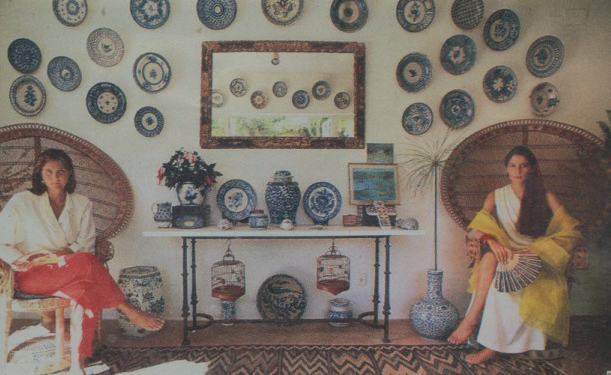
-You also did an internship at Yves Saint-Laurent…
I arrived at Yves Saint Laurent in 1980 through his Spanish muse Violeta Sánchez who was his ‘cabine’ model and also worked at the Bains Douches as PR.
I spent six months there, it was an incredible experience. I got to watch Monsieur creating in his studio surrounded by his team: Loulou de la Falaise, Madame Muñoz, his models Mounia, Violeta, Kirat… One day a hot new singer called Valli asked me if I could get her an YSL outfit for the French music awards. I convinced the PR office of her potential and, exceptionally, they lent her a couture tuxedo. I was terrified because my job was on the line. Valli was a huge hit that night, the song Chacun Fait C’qui Lui Plait became the number one song in the French charts. The PR office had given me long speeches about how risky this was because there was the image of the Maison to protect at all costs. Everything was about safeguarding “l’image de la Maison.” But the move was a great ‘get’ for them because it made the Maison accessible to a younger and cooler audience. They were thrilled and thanked me. It was there where I realized that I wanted to help artists.
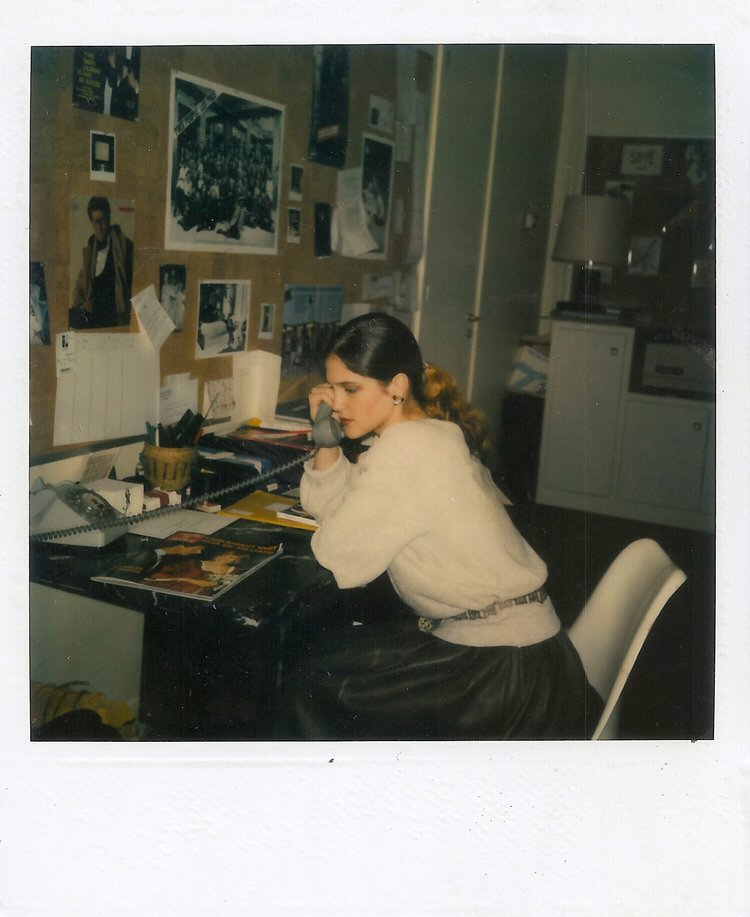
-Your first ‘client’ was Tony Viramontes. Tell me how this happened, how did you work and live in those times?
Another internship I did was with a fashion forecast office. Tony came in one day to offer his services as an illustrator for their forecast books, at 50 francs an illustration. He was dressed in black head to toe. He had also a black head scarf and long black hair. I had never seen anyone dressed in all black. It was 1981. I was like WOW! I loved his look and his demeanor…he was aloof, arrogant and also flirty in an ambiguous way: dangerous. When I saw his work, the unrestrained energy of those illustrations, I was speechless. That night I went over to his tiny studio and I said:” I love what you do, I’ll help you.”
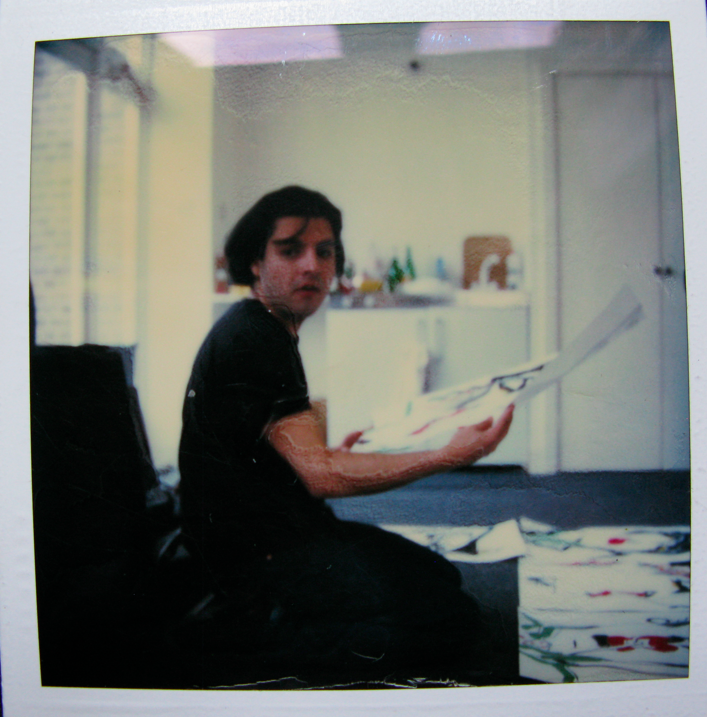
-How could you help him at that time?
I called Jean Pierre Joly, the head of Woolmark who I knew from YSL, and told him that he needed to see Tony’s portfolio, an elegant box of transparencies mounted in black cardboard… (I still have it!) In it he had all the work he had done at Parson’s New York, plus some commissioned by his mentor, the designer Hanae Mori. Jean Pierre said: ”You need more French designers in your book but I will give you the next Woolmark look book to do.”
For a month I called every single designer and requested their Woolmark look for Tony to draw. The new créateurs we had barely heard about: Yamamoto, Comme des Garcons, and Miyake, plus the big French names like YSL, Mugler, Montana, Jean Paul Gautier, Chanel and Alaïa… They sent us their total looks created for this seasonal presentation. Tony’s little flat became jammed with clothes and I modelled for him. I had a job during the day, so Tony and I worked at night.




-Was posing for him very different to what you were used to? What did you learn doing that?
I learned how to strike tortuous poses in huge wool coats and sweaters in the July heat. Graphic exaggerated poses that would show off the lines and cuts of the voluminous garments. From these sessions I learnt the exacting nature of Tony’s control and quest for perfection. Tony would do my hair and makeup: black smudges under the eyes, strong eyebrows and red lips. He shaved my hair and gave me an undercut with a Mohawk. He made me wear black scarves, knotted like his, pulled tightly down my forehead like a pirate. I had become one of his ‘creatures.’ Tony’s pencil strokes were intuitive. He would get into a ‘zone’ and drew fast, as if possessed. He also blasted Maria Callas from his boombox. It was exuberant and theatrical.
The Woolmark job was a huge success. But the first advertising commission we got, a series of illustrations for a Parisian department store, was a benchmark. Tony made the deal without telling me because the creatives were his friends of ‘the night.’ For a few hundred francs he verbally agreed to sign off on all his rights to that campaign. We got screwed and the campaign ended up running on all media worldwide for decades: billboards, shopping bags, bus shelters, in-store.
I learnt my lesson.
-What was special about his vision, why was it visionary?
At the beginning of the 80’s the girls that became famous were either the stunning models that worked with Bill King: healthy athletic girls like Cindy Crawford, Kelly Emberg or Iman. Girls that smiled and jumped, big hair blowing in the wind. Tony called him ‘Bill Wind Machine.’ Or the chic but unconventional creatures of the illustrator Antonio Lopez: Jerry Hall, Pat Cleveland, Donna Jordan, Tina Chow, his gang from Studio 54 and the New York disco days, ‘Antonio’s Girls.’
I remember having dinner at La Coupole with Antonio Lopez and the legendary PR Sylvie Grumbach. She invited us because she wanted to help Tony. Antonio Lopez was ‘The King’ at that time and Tony looked up to him and was motivated by his talent, success and power. Tony was very determined to become more famous than Antonio but the first thing he had to do was to put a wide divide between them so as not to be referenced as Antonio #2. The fact of being a Latino illustrator like Antonio, irked him. Unlike Antonio who had embraced his origins, Tony had always rejected his Chicano heritage. Tony also made fun of Antonio’s penchant for beautiful and theatrical girls and focused on creating his own brand of beauty: the ‘jolie laide.’
-Can you explain what was that approach on beauty?
They were androgynous scowling girls like Leslie Winer, Violeta Sanchez or Lisbeth Garber. Girls with angular faces and boyish bodies, long necks, strident noses. Girls that snarled and twisted when they posed. Girls that looked like boys who wanted to look like girls. More girls followed: Christine Bergstrom, Claudia Huidobro…his muses were unique.
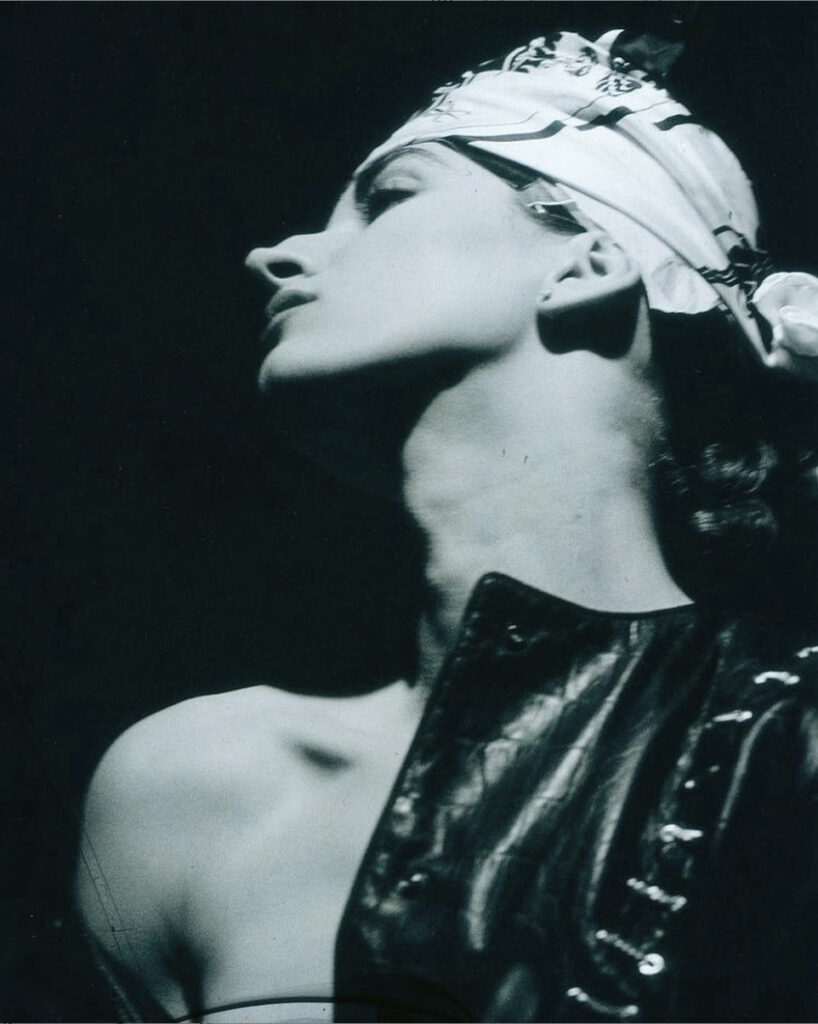
⠀




Left to right: Leslie Winer, Violeta Sanchez, Laurence Treil, Nick Kamen. By Tony Viramontes
-Did that attract more jobs?
Jobs started trickling in and I found a huge flat for Tony to live and work out of and that’s when the partying began. Tony’s friends from New York came in droves: Steven Meisel (Tony’s teacher at Parson’s) Teri Toye (the first trans model to become famous and win Girl of The Year) Way Bandy (Scavullo and Nancy Reagan’s makeup artist) Paul Gobals (a superb makeup artist from London) Matthew Rolston… Everyone crashed at Tony’s flat and never left. A Fashion Frat. Tony would dress me in men’s clothes and do my hair and make-up, I was like his malleable doll: I was Ken rather than Barbie.
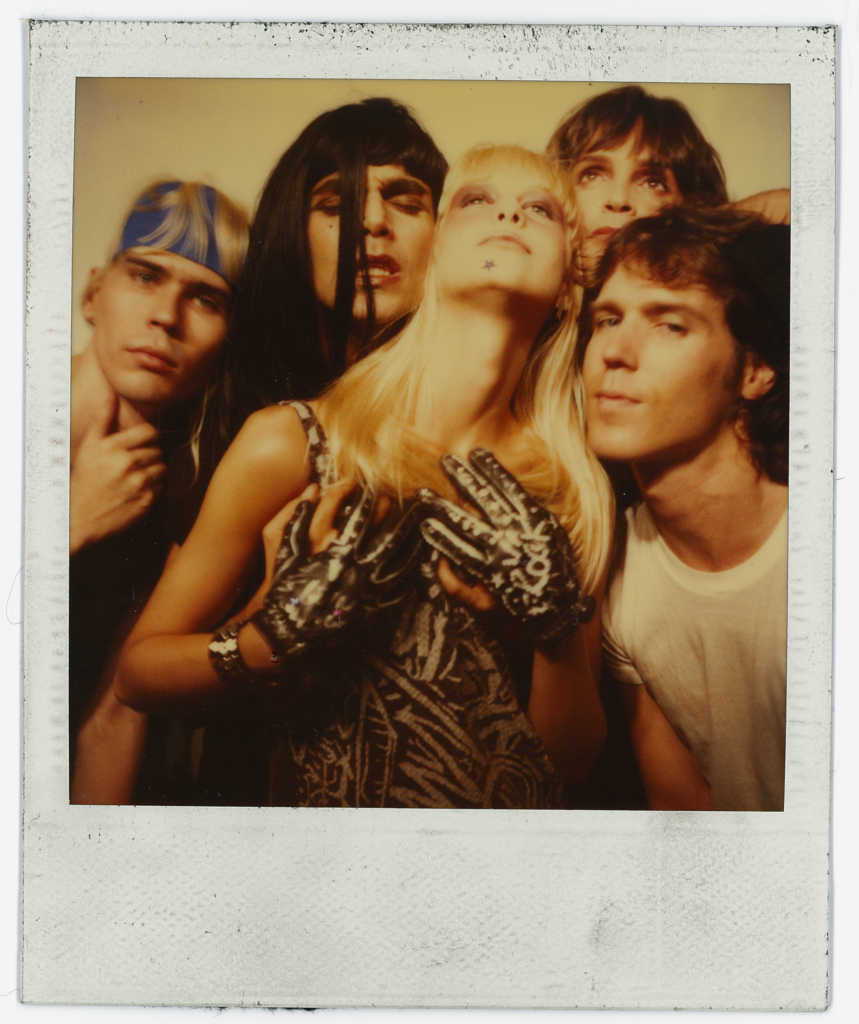
Courtesy of the Tony Viramontes Studio Archive
-That was a moment of hard partying, isn’t it?
We went out every evening to Club Sept, Le Palace or the Bains Douches. It was fun, the work was inspiring, his friends outrageous, until Tony started doing drugs and then it quickly became dangerous. I remember on one occasion Tony did not show up on a Complice shoot. I ran to his house to look for him. When no one answered I let myself in with my key. I will never unsee the tangle of naked bodies and used needles everywhere. An artist in Tony’s team overdosed during one of those orgies in Tony’s flat. My first death on the job.
-Part of the jobs he got were portraits, right?
Yes, he started producing memorable celebrity portraits: Paloma Picasso, Janet Jackson, Nick Rhodes…. He worked very fast. When he was drawing he would get into a trance. Music would be playing very loud and he would be oblivious to what was going on around him. He drew with wild strong strokes, slashed with a cutter, smudged with his fingers and elbow, splattered ink everywhere… grabbing anything that he could find on his table. Once he cut off the tip of a finger but continued working. Blood was spurting everywhere, but he did not even notice! He finished the work and I wrapped his hand in a kitchen towel and took him to the hospital to get it stitched. He passed out in the taxi.
-And then you moved to Milan…
In 1983 I was kicked out of France because I could not get a work permit and ended in Milan where the action was starting because of the new edgy magazines Lei and Per Lui, edited by Franca Sozzani, were attracting all the new talent. I set up my agency with an Italian partner. With Tony’s portfolio in hand, I knocked on every advertising agency’s door. The creatives would do a sign of the cross and say “Mamma mia, ma che brute queste donne!”” These women are so ugly!” Then I met the PR Maggie Newman. She raved over Tony’s work. Maggie sent me to her client Adriano Goldschmied who was looking for an artist to create a unified image of his group of labels called The Genius Group: Bobo Kaminsky, Diesel, Replay, Katherine Hamnet… He took one look at the portfolio and gave us the job: 15 pages to appear in the September 1984 issues of Vogue Italia, Lei, and Per Lui. He sent me to Franca Sozzani with Tony’s portfolio for approval, since it was an advertorial done in collaboration with Condé Nast Italia, a cross between advertising and editorial. Franca loved Tony’s work and hired us on the spot.
-Did he want Tony to do his usual illustrations?
No, the only imperative Adriano had given me was that Tony had to do something completely new. Tony wanted to use large format Polaroid so I rented a giant camera of the two that existed in the world. The Polaroid camera came in a truck with its own engineer from Germany, but Adriano’s entire collection of clothes that we were to shoot never arrived in Paris, so Tony shot the models partly naked, in their own clothes or mine and some accessories I brought to Paris, a lot of my mother’s stuff actually. Tony invented his signature photographic style on that shoot: collages of ripped up Polaroids, with bold graffiti all over them to make up for his lack of lighting techniques. The resulting images were sensational.




Nick Kamen, Christine Bergstrom and Lisa Rosen by Tony Viramontes for The Genius Group. Published September 1984. From the archive of Eugenia Melian
-And that attracted the attention of other magazines?
That same season my best friend from my boarding school days, Lucinda Chambers, was working as an assistant to Grace Coddington at British Vogue. I sent Lucinda the portfolio and she had the vision and guts to get a commission for Tony: eight illustrations of high-end hats, a lot of them by a young milliner called Stephen Jones. The hats were very couture and Tony used Leslie Winer and shaved her hair off to look like a boy. It was groundbreaking work and appearing in Vogue really validated Tony. After that and when the Genius Group campaign was published, it was as if a bomb had exploded on Planet Fashion. Everyone talked about the groupage and Tony ‘s career went into the stratosphere. Tony would go on to work with Franca for many years.




Leslie Winer posing for Tony Viramontes for Vogue UK. Paris 1980s. Rudy, Christophe, Scarlett, Mimi, Ben and Violeta. Polaroid by Tony Viramontes for The Genius Group January 1985. From the archive of Eugenia Melian. Tony Viramontes for Lei and Per Lui 1980s
-You both did a lot of work for Valentino after that…
Franca introduced Tony to Valentino because his business partner Giancarlo Giammetti was looking to modernized the image of the couture. Tony deconstructed the parameters of what you “should and should not do with couture.” Valentino’s office put Tony in a vast suite at the Hotel de la Ville in Rome for a month and I would fly in models from New York on the Concorde just for the day. The girls of course never left and Tony’s suite became like party central in La Dolce Vita. Valentino’s office sent me the bill one season because there were splashes of black ink and pinholes all over the silk drapes and rugs.
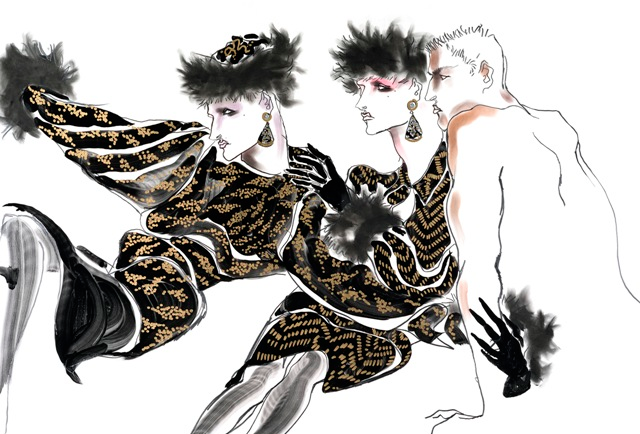
-How did you choose the name of your novel “Wildchilds”? the correct word would be “Wildchildren,” right?
I just like the way Wildchilds sounds and looks. It’s not a word, but it’s evocative. I registered that domain many years ago knowing that one day I would use it, I would create content just for that name. Crazy, no? So, the story in Wildchilds comes from a word that I love which does not even exist. But you have to start somewhere. The name Wildchilds gave me the sound and visuals of the story I wanted to tell.
-Your novel is a story of love and loss between a model and a photographer but it has many crucial aspects regarding the world of fashion, denouncing it many times, but other times as an homage. Was it difficult for you to balance out these two stances, that relationship of love/hate with the fashion world?
What has always been the most difficult throughout my career was to explain my passion for the art of fashion to people. As an agent working in various artistic fields such as music, dance, video or the movie and TV industry, I had noted a kind of dismissal of the fashion industry. The common factor is that the fashion industry exists in its own little bubble, far removed from the beat of the street, but it has the budgets and the flexibility to be able to employ artists across all disciplines and collaborate with them on specific and one-off assignments. In my case, I have always had a love relationship towards it. I have lived inspired by the art of it and its people; the artists that make beautiful clothes or create meaningful images.
-But there is a “hate” side to it too…
The ‘hate’ part of the relationship is towards the people who are there for the wrong reasons, people that work in this industry because you are led to believe that you need no skills to become a PR or an editor or a model booker.
I have been lucky to work with very prepared and extremely talented professionals and I have worked in every single aspect of this multi-billion industry. I have managed, produced, created, art directed, cast or negotiated over one thousand jobs representing dozens of artists and projects in every field: advertising campaigns, music videos, book publishing and launches, musicals, fashion editorials, soundtracks for films, sound design for fashion shows, art exhibitions, parties, two albums, castings, music for the Olympics, content for TV, digital series… there is little that I have not done. I have worked with excellent people and I respect the industry, but some of the players scare me. They represent everything that is wrong with it: the love of the surface, the lack of culture, intellect and references, the lazy thinking, the abuse of power and the ruthlessness of a world that goes so fast: using and discarding new talent every season. As the fashion business got bigger and conglomerates were formed, it has gotten worse. This pressure and pace create instability, it contributes to mental stress and bad things happen. The love of the industry for your artists lasts but one season, then you are out.
-One of the catch lines advertising your book reads: “beautiful people do ugly things” …
The collateral damage of the industry is something we should deal with and can no longer ignore. Fashion, like other arts, embraces the ‘eccentrics,’ the ‘originals’ but behind that excess that we encourage, sometimes lurks mental health issues that go untreated and on the contrary: are embraced. Then shit happens, but the people in the industry turn a blind eye for fear of retaliation.
Last but not least: where beauty, innocence and youth cohabitate, predators roam. It’s a fascinating but dangerous world that you have to come to prepared. As years went by I became more politically involved, more informed and aware. Representing artists such as Matthew Herbert and Malcolm McLaren made me reflect and act, and become more selective about the clients or brands that we worked with. That too is reflected in Wildchilds. It is not just about the money and art of fashion, you need to have a strong political stance and POV, you have to inform yourself about the brands that you work with or wear and you have to be very moral, ethical and respectful. You also have to learn to turn down jobs even if you need the money and most importantly: you must say why you turned the job down.
-Did Tony inspire the character of Gus, the photographer in your novel? I get that feeling from how you describe the way in which he works…
Yes, but not only. Gus is part Tony of course but also part all the kids that I have represented: the creative chaos of their little flats, their unfettered passions, the way they talked when they pitched me an idea, the worlds in their heads, what they did to get by. Some of these good kids that I represented had very hard lives, one became a male escort to support himself, another one became a drug dealer. It was so hard for me to watch, I wanted to help and protect them all, but like them, I was very young and needed someone who would look over me.
My first years in Milano were brutal at times. Struggling to pay the rent and even eat. I was the only woman agent there at the time, I was 23 years old. There was another woman agent in Paris, the wonderful Marion de Beaupré, but she was a generation older than me. My young photographers and myself sort of ganged up together for survival.
The Milan modeling agencies were ran by playboys who went to parties with their underage models, it was disturbing. When in 1984 an American model called Terry Broome shot and killed a wealthy party boy called D’Alessio, we spoke of nothing else. I began to feel less insecure when Tony started working, it was the validation that I needed to prove to myself that finally I was doing something right.
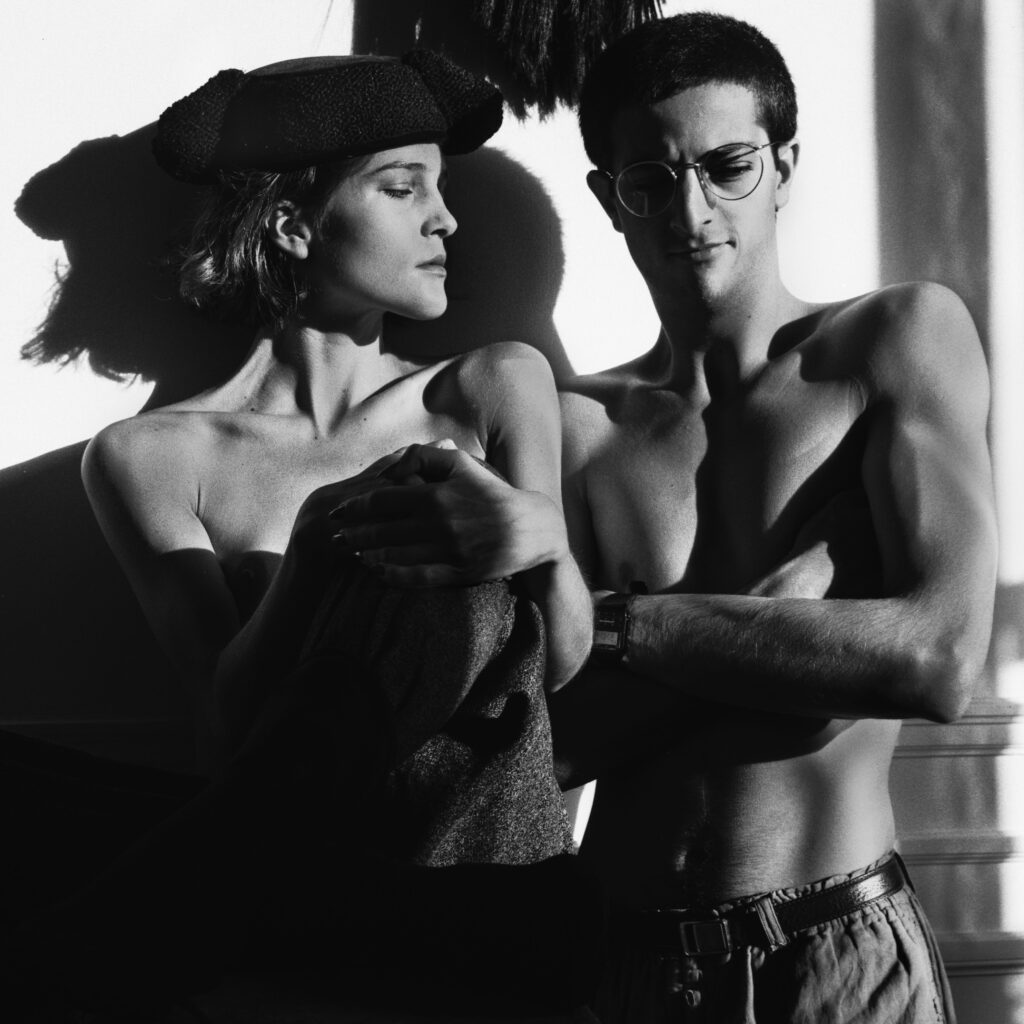


Eugenia Melian for Romeo Gigli. The Sunday Times, Milan 1988.
Below Eugenia by Alejandro Cabrera Vogue Italia 1986. Eugenia Melian by Pamela Hanson. Madrid 1986.





Eugenia for Glamour France. Photographed by James Calderaro. Milan 1986. Eugenia Melian by Pamela Hanson. Madrid 1986
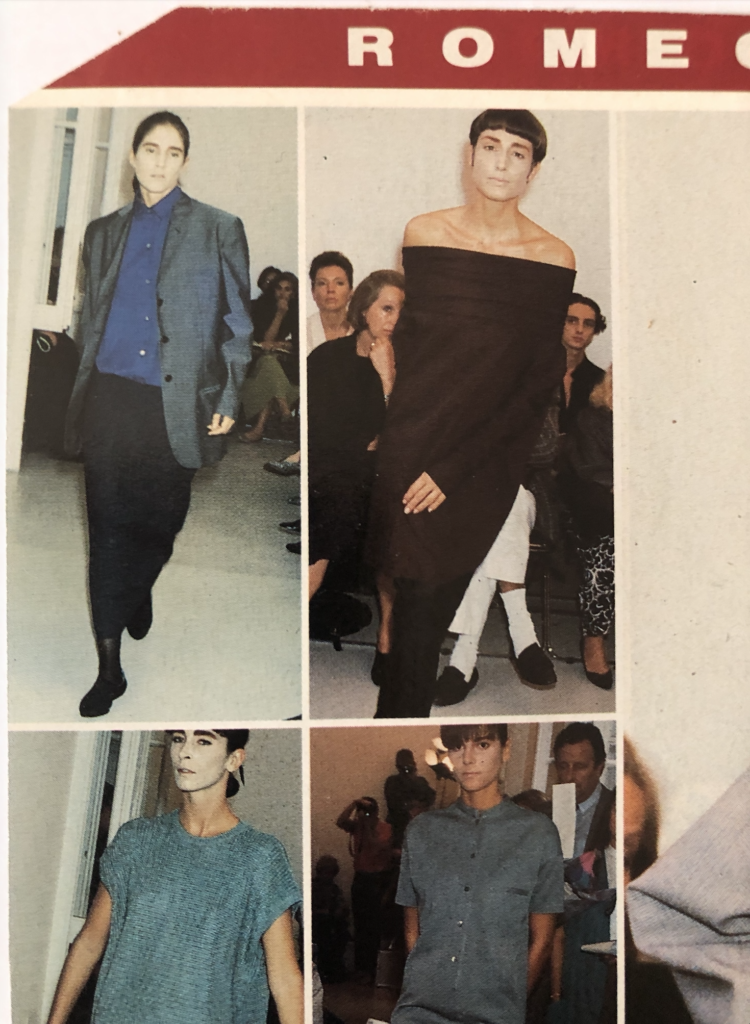
-One of the valuable elements that the novel has is that it is very didactic, for example, in the way in which it explains through the mother of Iris, the protagonist, the figure of a magazine director, what it means to have a point of view and the importance and influence that this has on society. Regarding this topic, did you get inspired in someone for this character?
Correct! It was a priority for me as an insider to show that complex process through a series of scenes. I had always felt cheated with the depiction of the industry in certain movies and books, I felt it only skimmed the surface, dumbing down the long hard process. Editors don’t just pull ideas out of nowhere. A lot of culture, references, knowledge and knowing where things came from are behind all that. Brilliant editors such as Lucinda Chambers and agitators such as Joan Juliet Buck have inspired me throughout my career. So, Iris’ mother, the editor in chief of Revue, is a layered compilation of editors, stylists, journalists I have worked with, plus my mother.
-And of course, the rest of the team…
Yes, I needed to show how those abstract ideas were translated to tangible images through the work of a photographer, his model and the team; always the team: hair, make up, set designers, camera assistants and stylists. No one talks about them, but they are just as important and key figures in the creative process. I describe in great detail what happens when there is chemistry on a fashion shoot, that magical moment that takes place between a great photographer and a unique model. I also needed to explain that you cannot control what happens on a shoot, no matter how much you pay. Sometimes IT happens, that moment, sometimes it does not, but when you live through one of those spine-tingling fashion moments, everything, all the blood sweat and tears, becomes worthwhile.





1/ Set designer Kristen Vallow on the set of David Lachapelle’s portfolio for Stern magazine. Paris. 2/ Set designer Kristen Vallow and the late lighting director Jake Langbehn on the set of David Lachapelle’s Cool Britannia for Vanity Fair, Blenheim Palace, 1996. 3/ Make up artist Topolino and model Jodie Kidd on the set of David Lachapelle for Vogue France Haute Couture. Chateau de Vaux le Vicomte France 1995. 4/ Production meeting in my kitchen for Vogue France Stripes shoot. David Lachapelle and set designer Kristen Vallow. Paris 1995. 5/ Set designer Kristen Vallow on the set of David lachapelle’s Cool Britannia shoot for Vanity Fair, Dec 1996. All photographs by Eugenia Melian.
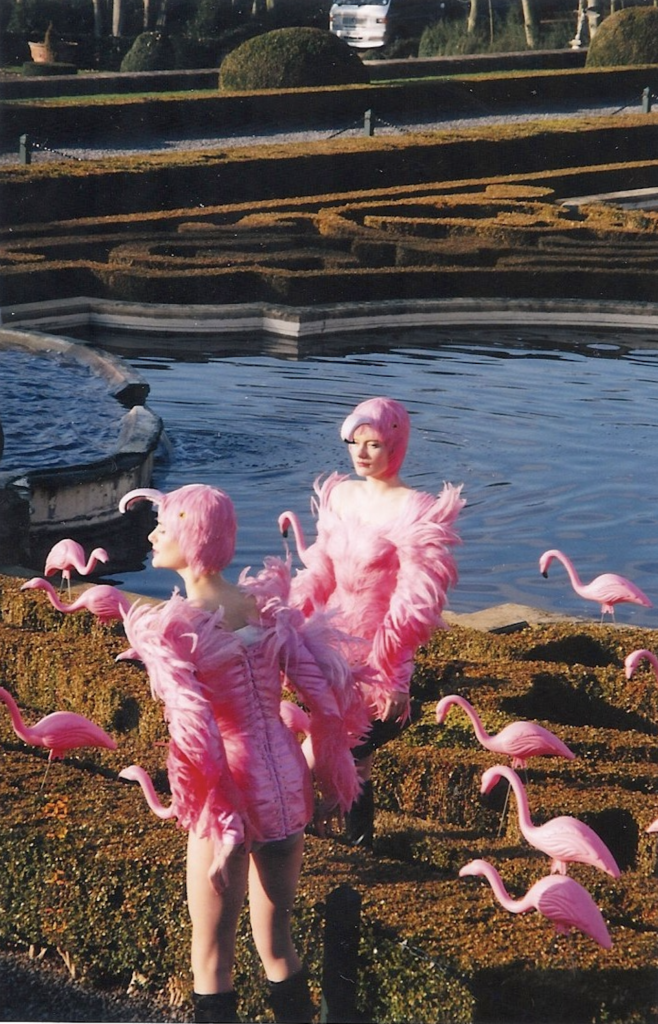
Regarding magazines, I still love them and I subscribe to many, preferring print over screens. Before the internet we used to get all our information from the magazines: what to wear, hotels to stay in, music to listen to, places to travel to, movies to watch. You waited anxiously for a month until the new issue of Vogue Italia came out and then you passed it around to your friends. You also tore out the best pages and stuck them on your walls. With digital, things have changed radically. Everyone has access to the same information within minutes, the cycle is short and fast. Consumers are dictating their own fashion likes and dislikes and the monologue has become a dialogue where everyone wants in. Fashion has become less “exclusive.” On the business aspect, as all these fashion companies go public or become conglomerates, the magazines have lost editorial control and the voice and aesthetics are being dictated by the advertisers. Readers are losing trust in this “pay to play” economy. Also, creatively, with the arrival of digitech, the magic on photo sets is gone. Clients now stand by the digital capture monitor behind the photographer, and have an instant view of every single shot that is taken. They voice their opinions to the technician and stop the flow. Everything now can be fixed on postproduction.
-How about the way in which women’s image is treated?
Well, there are serious global issues we are having to process right now: climate crisis, inequality, consumerism, racism, exclusion, #MeToo, pandemic…I think it’s time for magazines to embrace the current mood and become more engaged, more responsible. In America for example, women politicians and activists have taken over very important spots at government levels, and we have seen huge turnouts of women voters in the last elections; why not give them more of a voice? Why not have more pages featuring women’s issues, and less pages exploiting their sexuality? I think the women in these pages want to be more authentic, confident and not sexually objectified.
– You describe in the novel those parties in the Bains Douches. Tell me how was the atmosphere there at the time, do you have any anecdotes?
Dangerous. You were always one dance, flirt, glance, line, gulp, puff away from something horrible happening to you, but of course we did not know then. That was the feeling at Les Bains Douches. You did crazy things because the music was loud and good, the space tight and sweaty and there were more celebrities packed into a square meter than in any other place that I knew. There was none of that bullshit American VIP area thing. Everyone danced, popped, dined, mingled with everyone. If you could get in! But once inside there were no “off limit” areas. Then there was the pool…. crap! That pool. I ended up in the pool once, everyone took off their evening dresses and paddled around in their underwear. After you have seen your client in his briefs in that pool, it takes a lot of aplomb to face him the next morning at a preproduction meeting.
-Was there another special place where things happened?
Another place that was the epicenter of all this partying was the restaurant Anahi. The owners Pilar and Carmina were Spanish, they became friends. Two or three times a week we would meet at Anahi, drink lots of pisco sours, get buzzed and dance on the tables. Anahi would close for us and we could stay till late. At the beginning of the evening Pilar or Carmina would ask you for your door code so that if you got too smashed they could put you in a taxi and give your door code to the driver. The owners loved to party. It became a sort of private club for us. One evening the artist Miguel Barceló took my lipstick and liner and doodled all over my body, covering every inch of my skin in beautiful scarlet motifs. We got on his scooter and crossed Paris to go to Les Bains. Thank god we had no smart phones then. Everything has been ruined by the arrival of social media and phones with cameras. We did not give a damn before…instead of taking a selfie I took a shower and Barceló’s art was washed down the drain in lieu of being immortalized on Instagram. I love that. The only people who recorded all those years were the photographers of the night. They are two famous ones in Paris still working. I cannot even imagine the pictures that they have and that no one will ever see. Wildchilds talks about that too.


Christine Bergstrom and Eugenia Melian at Anahi. Paris 1990’s. Pilar and Carmina of Anahi. Paris 1990’s


Susi Wyss and Eugenia Melian at one of my many parties at home. Paris 1990’s. Susi Wyss and David Lachapelle. Photographed by Eugenia Melian. Paris 1990’s


Eugenia Melian and Laurent Mercier a.k.a Lola. Paris 1990’s. Eugenia, Blanca Li. New York 1994. Malcolm McLaren’s Paris album release party


Blanca Li and Joan Juliet Buck. Photographed by Eugenia Melian. Paris 1995. Aymeric Vin Ramarony, Eugenia Melian, Madonna, Blanca Li, Carlos Leon, Laurent Mercier a.k.a Lola. Paris 1994


Eugenia Melian and Peggy Sirota. Paris 1990’s. Yannick Noah and Eugenia Melian. Paris 1993


Domiziana Giordano and Eugenia Melian. Paris 1990’s. Dominique Figaro, Eugenia Melian, Violeta Sanchez. Paris 1991


Eugenia Melian, Iman, Victoria Melian New York 1980’s. Eugenia Melian For Vogue France. Photo by Glenio Bonder. Paris 1994
-In the novel you tell some horrendous things related to the dark side of fashion. Are they things that you have invented or have they really happened?
90% of what is in Wildchilds is true and has happened. Things I have witnessed, people that I knew. The other 10% is based on my imagination, but could be true.
– At what time and how does David Lachapelle appear in your life and how do you start working with him?
In 1993 I was back in Paris and set up my agency there after living and working in Los Angeles with Malcolm McLaren and Peggy Sirota for a couple of years. An American friend brought his portfolio from New York. I took one look at David Lachapelle’s book and decided to take him on. His portfolio consisted of black and white portraits for Andy Warhol’s Interview as well as art photographs of naked boys with big angel wings. How all this could translate to fashion I had no idea but the work was very exciting, powerful, extravagant and most importantly: soulful. It took a few years to get him commissions because in Europe his work was seen as too kitsch, too full of American references: pizza slices, pink Cadillacs, strippers with big breasts…. In London, Paris and Milan, the early 90’s was the era of grunge and ‘heroin chic:’ skinny waifs with no makeup, shot in natural light in grimy settings, but David’s work was about angels and colorful portraits of celebrities staged in studios full of props. At that same time Pedro Almodóvar and the designer Sybilla introduced me to a Spanish modern dance choreographer that had just set up in Paris: Blanca Li. In order to subsidize her dance company Blanca was also organizing parties that were amateur cabaret shows called “The Worst Cabaret Show in The World.” We had so much fun doing those! They were by word-of-mouth only but the news spread: Lenny Kravitz, Madonna, Azzedine Alaia, Christian Lacroix, Vanessa Paradis came, but when the cabaret became too famous three years later, we stopped.
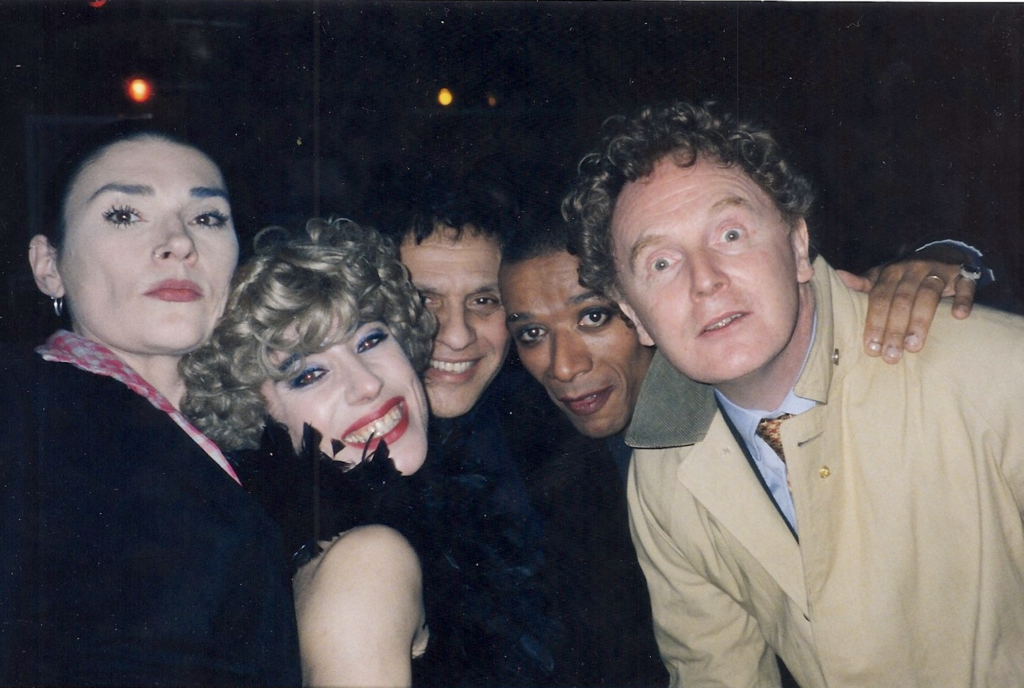
-And what were you doing for Malcolm McLaren?
I was getting him commercial work and producing with him a series I wrote for BBC2. The Eugenia Melian agency of those early 90’s years was a motley crew of unique untapped talent. It was Joan Juliet Buck, freshly appointed editor in chief at Vogue France, who was the first to hire David Lachapelle for Condé Nast. Joan’s support for Blanca Li and David validated their work in a mainstream way. I decided to invest my own money into building David’s portfolio in order to launch his fashion career. For lack of budget and because his productions were so ambitious, I ended up flying David, his team and all his props to Paris and putting them up in my home office. My living room became littered with boxes full of accessories and sets, we even flew in from New York a box of stuffed skunks and a two-meter tall plaster statue of a David! Lachapelle slept in the living room on an antique daybed which we covered with a futon. Parts of my kitchen and guest shower were painted in neon colors as needed for the pictures. By the time he shot the Vanity Fair Cool Britannia story a few years later, the budgets were already astronomical. I was on set with Alexander McQueen and Isabella Blow when he shot the iconic image of McQueen in a corset and long skirt running away with Blow from a burning medieval castle. The special effects people had a permit to rig torches that would blow flames out of every window in the castle. The operation was to be supervised by the local fire department. We had a limited window to accomplish the shot because we were losing light. We waited and waited, the horse was stomping under the constricting clanging armor and then the producer got the call we were all dreading: the fire department could not come because they had been sent on an urgent call to put out a real fire. David said to hell with this and instructed his team to light up the blowtorches anyway. It could have been a disaster, David could have burned the castle down, and in fact I saw black singed marks on the windows when we left.
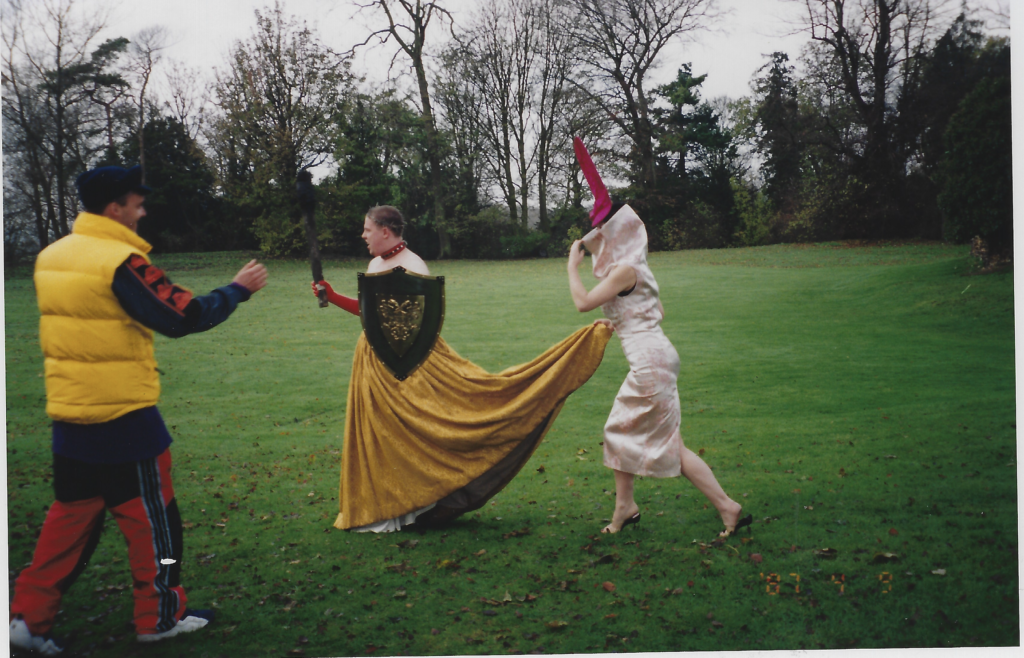
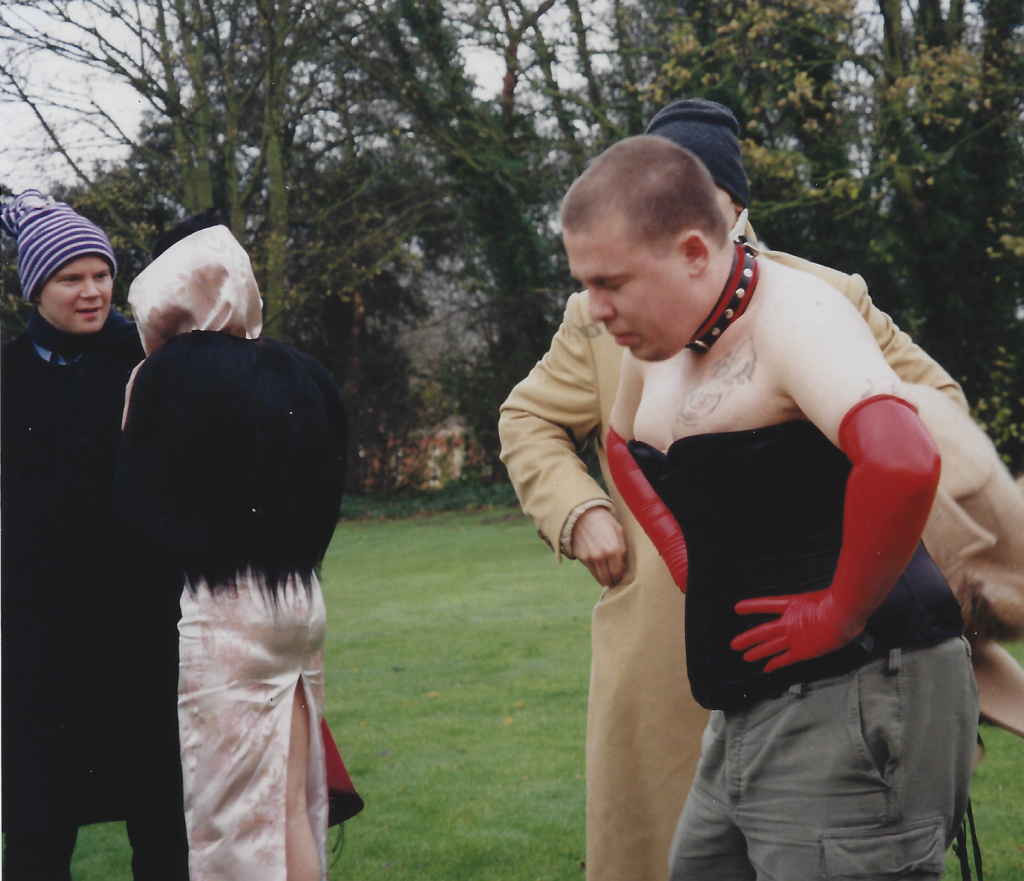




Eugenia Melian’s apartment in Paris became a set and production office for David Lachapelle’s Stripes story, Vogue France 1995. David Lachapelle and the production assistants painting my kitchen to shoot in. Box of props and skunks were flown in from New York. All photographs by Eugenia Melian.


Eugenia on the set of Blade Runner for Vogue France by David Lachapelle 1994. Right: on the set of Stripes for Vogue France. Paris



Christélle Saint-Louis Augustin and David Lachapelle on the set of David Lachapelle Vogue France Haute Couture shoot. Mini France 1995. Jodie Kidd & David Lachapelle on the set of David Lachapelle Vogue France Haute Couture shoot, Chateau Vaux Le Viconte 1995. Jodie Kidd and Angelique on the set of David Lachapelle Vogue France Haute Couture shoot. Mini France 1995. All photographs by Eugenia Melian.


On David Lachapelle for Vanity Fair Cool Britannia set Eugenia Melian with David Lachapelle, production designer Kristen Vallow, Jake Langbehn and extras, 1996. Photo by Eugenia Melian. Eugenia as an extra on a David Lachapelle set , Los Angeles 1990’s with Steven Meisel look-alike and producer Yannis Mangematin.
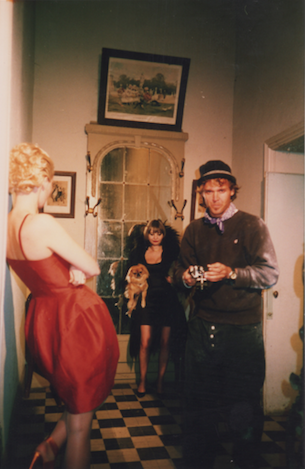
-In Milan where you were very close to Romeo Gigli…
He was the new designer that Maggie Newman had taken on as a client. Because of lack of budget, she asked me and her sister-in-law Gerlinde Hobel to model that first presentation. I fell in love with his clothes. Masculine suits in exquisite fabrics and coats with narrow shoulders which draped over the body like the petals of a tulip. His pieces were stunning, I had never seen anything so delicate and yet assertive. Romeo’s ‘woman’ was the woman I wanted to become through those clothes. I became friends with Romeo and modeled for him at every occasion in exchange of those clothes. During those early years I met a fantastic German girl who spoke Japanese and who was collaborating with a bunch of brands: it was Karla Otto. I took Sybilla to Karla who introduced her to the Gibó fashion group and they turned Sybilla into an international and successful brand. During those exciting years I also modeled for Yohji Yamamoto and Comme des Garçons amongst others. I had that weird androgynous look that was the fashion then. Many of my modeling experiences in front of the camera as a model or behind the camera as a photographer’s agent and producer, are used in Wildchilds.


Eugenie Vincent, Alex de Betak, Eugenia Melian and Christine Bergstrom after Sybilla’s first fashion show. Milan 1988. Eugenia with Sigfrido Martin Begué and Pedro Paz. Milan 1988.

-One of the things that you explain very well in Wildchilds is the photographic archive in the pre-digital era or the details related to copyright, intellectual property, etc., that people who are not in that industry do not know … And in relation to that same topic, the issue of the importance of legacy.
I have always been concerned about or interested in photographic archives, legacy, intellectual property. I have my own archive: hundreds of boxes in storage with the folders of those decades. I started working pre-fax machine, pre-email, so everything was on paper and filed away. For each job I have precious documents, doodles, letters, sketches. I have my photographic archive. I spent all my life taking pictures with my pocket Cannon. I have taken pictures of everything and everyone. When in 1983 I broke up with a boyfriend in Paris, out of spite, he threw away my albums. So basically, I do not exist photographically until after that year, 1984. It’s a shame because I had fun shots where, experimenting with fashion, I look like a fright! Most of my pictures modeling are lost forever. So many good moments gone and now only exist in my memory. Regarding archives and legacy: I was shocked by the stories of photographers who sold their negatives in order to buy drugs, another one who burned his whole archive because he was high, or the story of Vivienne Meyer whose archive was bought at auction for a few dollars, saving it from destruction. A very famous photographer who I knew personally, sold his entire body of work and intellectual property to a massive archive who is now using those unique pictures to sell everything, from condominiums, to air fresheners. They paid him so little because he needed the money and that archive is generating millions today. Tony’s archive sat in his parent’s garage in LA for four decades in the original FedEx boxes. It could have been damaged beyond repair. If you are an artist it is important to protect your work and leave behind a legacy. In Wildchilds I also explore the non-tangible legacy, what an editor in chief such as Delfine leaves behind, her personal stamp which defined the magazine Revue and which got obliterated with just one issue by her replacement. Fashion houses which have had strong legacies are turned inside out by the new recruits, the new designer who wants change everything at all costs. But is all that good in the long run? Or does it all just become the same in the end?
-In fact, you keep the files of Malcolm McLaren, can you talk about this and your story with Malcolm?
I met Malcolm in 1889, after I was hired by CBS Music to produce the launch party for his new album Waltz Darling, an album about voguing. With the help of Carla Sozzani and Romeo Gigli we put on a massive party at the parking lot that became later the concept store Corso Como 10. It was a huge success. Willi Ninja and his House of Ninja were flown in from New York by CBS to do a voguing demonstration and thousands of people crashed the party. I was engaged to Malcolm a few months later and we moved to LA where he had been working in the film industry for a few years. It was a rocky relationship because Malcolm was a brilliant but a very complicated and destructive person. Slowly I became part of his team and worked on one of his projects: the making of a hip-hop band, the recording of the album and styling the shoots and music videos. In order to remix some of the tracks from his cult album Duck Rock I was sent to the record company in London who supposedly had all the multi tracks of these recordings. I matured musically in the early 80’s to the world sounds of Duck Rock. It was the most astounding musical journey that had ever been created. The first ever example of world music. The head of the A&R department announced calm as a cucumber that those analog tapes, hundreds of them, were lost. I remember standing there with my mouth wide open. The 48-track tapes of songs like Buffalo Gals, Double Dutch and World’s Famous were gone forever. It was 1990 and I remember sitting in the lobby at the record company crying my heart out. Analog multi-tracks are very big and extremely heavy things, there must have been hundreds of those, sounds recorded around the world over the duration of two years. How can anyone misplace a tower of boxes weighing a few tons?




Eugenia Melian with Malcolm McLaren. Milan 1989. Eugenia Melian and Malcolm McLaren at the voguing party for the release of his album Waltz Darling at Carla Sozzani and Romeo Gigli’s Corso Como 10. Milano 1989. Bertie de Rougemont, Eugenia Melian and Willi Ninja from The House of Ninja. Voguing party for Malcolm McLaren at Carla Sozzani and Romeo Gigli’s, Milan 1989. Eugenia Melian and Willy Ninja at Corso Como 10. Milan 1989.


Loulou de la Falaise recording the Malcolm McLaren Paris album, 1993. Eugenia Melian in the studio during the recording of the Paris album by Malcolm McLaren 1993. Below Malcolm McLaren & Françoise Hardy in the recording studio for Malcolm Mclaren’s Paris album, 1993. All photographs by Morgan Schmid
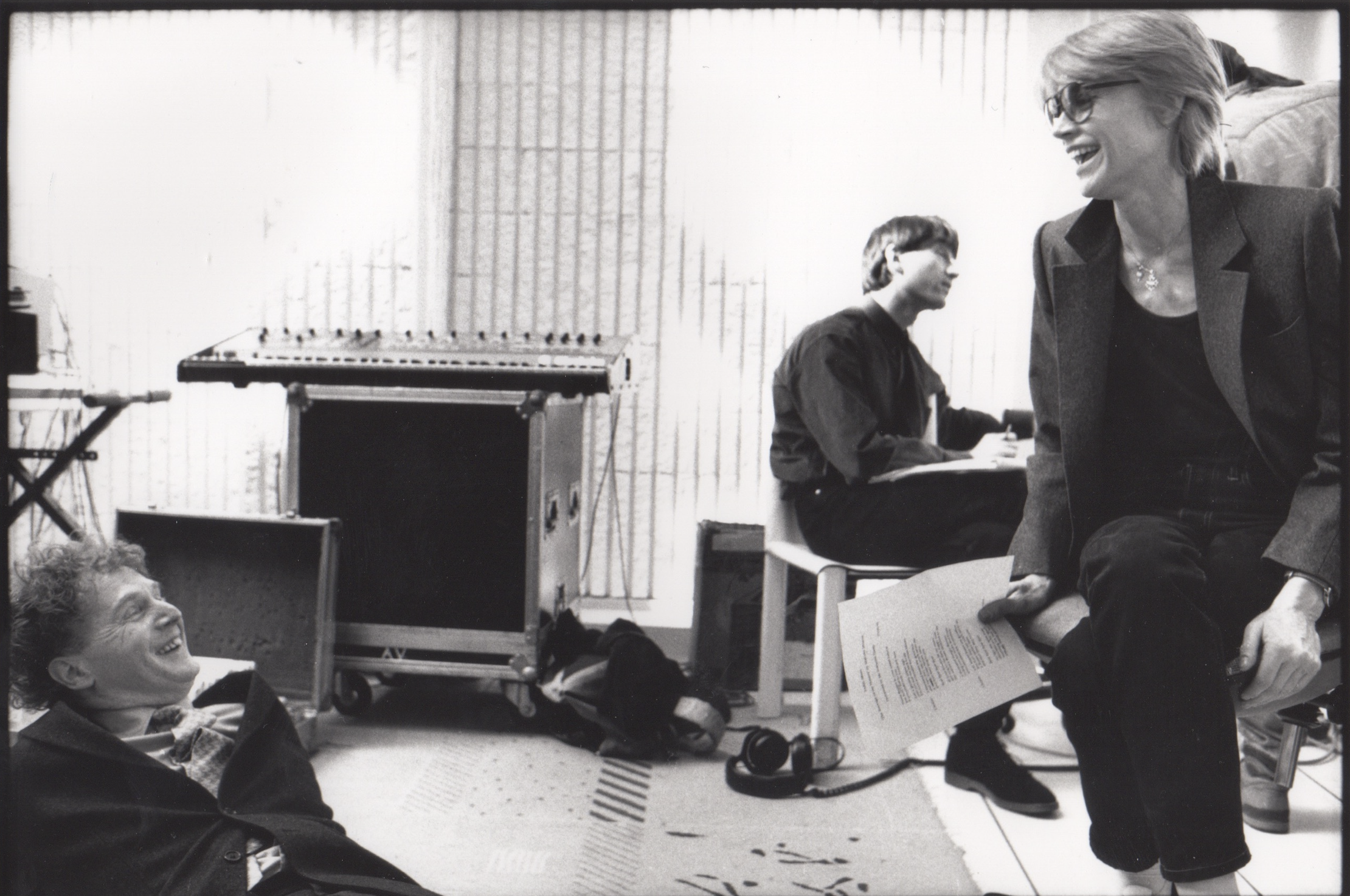
When we left Los Angeles to live in Paris we sublet our home to an English artist. Little did we know that he was a junkie and would turn our home into Party Central. Malcolm’s library of rare books, his personal art, my Romeo and Sybilla clothes, my signed photographs, everything was stolen or peddled for drugs. When we moved what was left to Paris, Malcolm decided to store his archives temporarily in my cellar. I warned him against it: a damp cellar was not the place to store his Sex Pistols files, his scripts, his comic book collection, all his pictures and correspondence…but Malcolm was like that: unconcerned and unattached. One year later, that McLaren archive was destroyed when the cellar flooded, another devastating loss. I finally learnt my lesson and during the eight years that we worked together I kept every single piece of paper, sketch, notebook… We did many projects together: the Paris album which I created for Catherine Deneuve, Françoise Hardy, Sonya Rykiel and Loulou de la Falaise, the music for Jacques Chirac’s electoral campaign, The Ghosts of Oxford Street: the TV musical for Channel 4 that he wrote, directed and starred in featuring Sinead O’Connor, Tom Jones, The Happy Mondays, The Pogues…it is all there, stored away with a professional storage company. From Malcolm I learnt about pushing boundaries to the extreme, never feeling safe creatively, risking everything for your beliefs and never ever giving in to mediocrity. To quote him: ‘Good is boring. Bad is good.’ Finally In 2025, my 1989-1997 archives were acquired by Yale / Beinecke Library


Eugenia Melian with Tom Jones on the set of The Ghosts of Oxford Street written and directed by Malcolm McLaren. London 1991. Lauren Hutton and Malcolm McLaren. Paris 1991. Photographed by Eugenia Melian


Malcolm McLaren tagging Shawn Stussy. Shawn Stussy tagging a car. London block party 1990. Photographed by Eugenia Melian
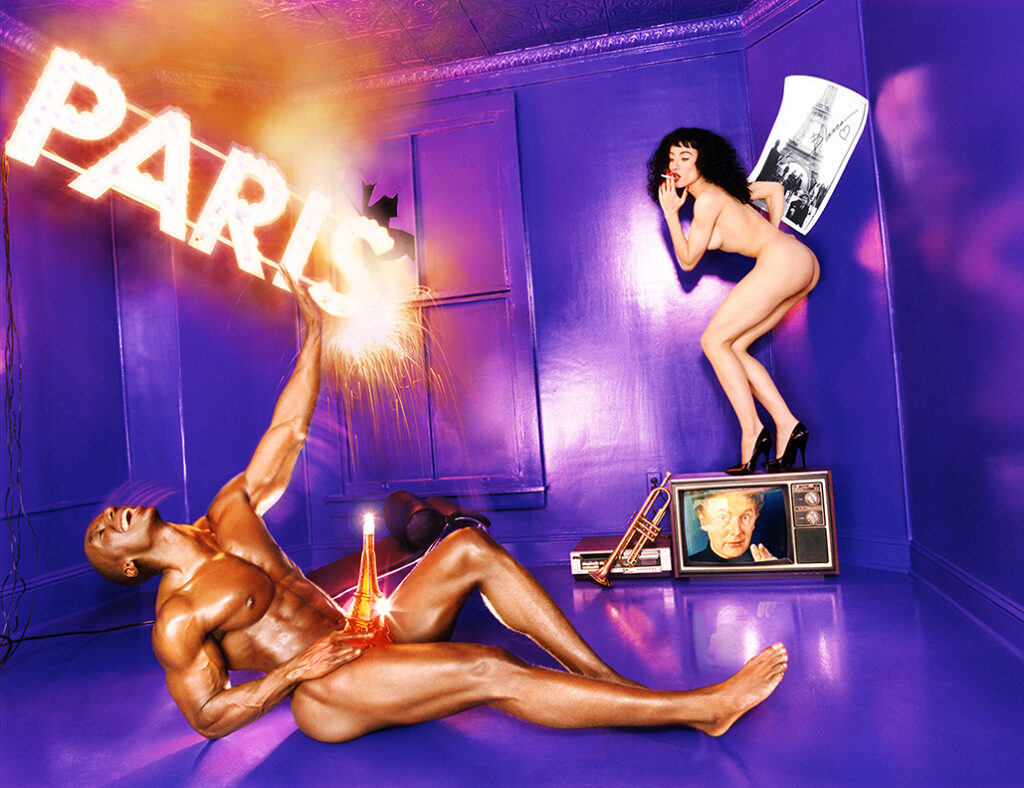
-I know you treasure many beautiful garments of those years of your life. Tell me what your most precious possessions are.
In the 80’ and 90’s I was a size 34. I fit into a sample size and a lot of times I worked in exchange of good clothes. I have some stunning pieces that I will never part with: high-waisted silk Romeo Gigli pants in acid colors, coats and men’s suits, many slinky Yamamoto, Demeulemeester and Margiela dresses…also a lot of my mother’s vintage. I am appalled by fast fashion. The environmental impact of cheap mindless shopping is something that the entire industry must address, not just a few designers like Stella McCartney or Katherine Hamnet. We all have a responsibility to know what we are buying, how it is produced, how are the people that make your clothes are paid and treated, and how it impacts the planet on a socio-political way. Buy much less, buy better.
I am still wearing my mother’s clothes from the 60’s and 70’s: they are timeless and so well made, they will last forever. I had my suits and coats made by John Pearse, a superb tailor on Saville Row and most of those suits are now 22 years old. Every year I buy a couple of vintage silk blouses from a secret shop in Paris. I have a kind of uniform now. I am very politically aware and informed, in tune with how the advertising agencies sell their products. There is something to be said on the subject and which I reflect on at length in my novel: not every woman wants to run around in a pair of high heels showing a lot of breast just to seduce a man. Most men don’t even like it when you wear makeup! Some women prefer to remain invisible and comfortable and most women dress in order to please other women, not men. I am fascinated by the self-expression aspects of fashion. What you decide to wear each day determines how you are going to feel: from ‘fuck me’ to ‘fuck-off.’


Eugenia Melian and Rocco Siffredi Paris 2004. Eugenia on set 1990s



In her favorite Romeo Gigli suit, Eugenia Melian with Shawn Stussy. London 1990. Shawn Stussy & Blanca Li. Paris 1990’s. Angelica Huston, Rossy de Palma & Fabrizio Chiesa, Paris 1992. All photographs by Eugenia Melian



Leila Smara, Brahim Asloum, Eugenia Melian on the set of Ali Mahdavi for Vogue Hommes, Paris 2003. Amanda Lepore & David Lachapelle at the Lachapelleland book launch at Armani, Milan 1996. Fabrizio Chiesa & Kyle Minogue. Paris 1990’s. All photographs by Eugenia Melian


Eugenia Melian & Peggy Sirota Paris 1992. Karla Otto & Eugenia Melian Los Angeles 2002.


Ettore Sottsass, Helmut Newton, Emanuel Ungaro. Antibes 1990’s. Malcolm McLaren & Robert Altman on the set of Altman’s movie Prêt á Porter. Paris 1990’s. All photographs by Eugenia Melian.


Ariel Wizman, Chavela Vargas, Pedro Almodovar, Edouard Baer at Radio Nova, Paris 1994. William Claxton, Peggy Moffat and David Huffy at the Fahey Klein opening for the launch of Peggy Sirota’s book Guess Who? Los Angeles 1990’s. All photographs by Eugenia Melian.

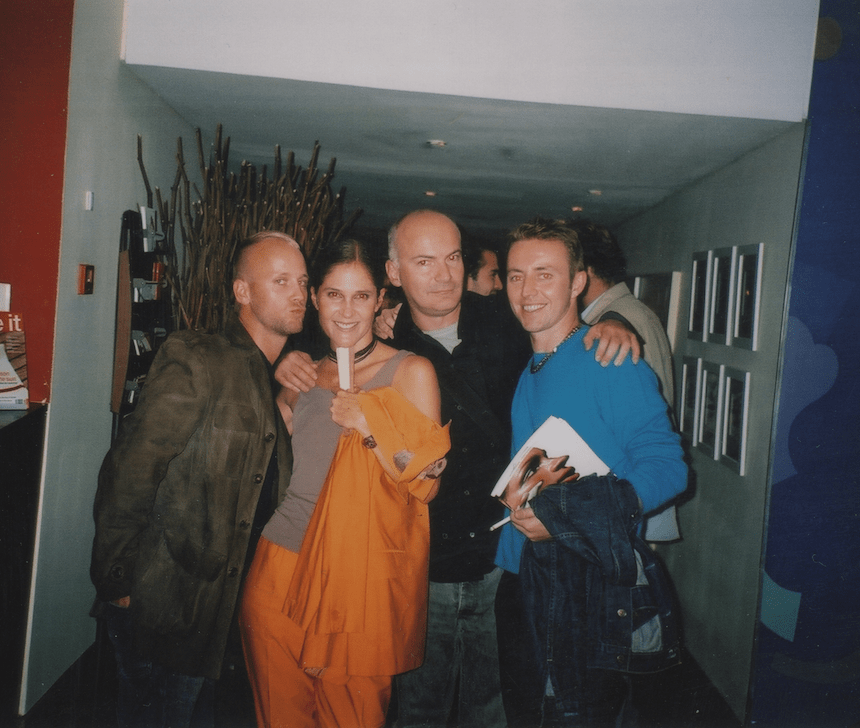

Margherita Missoni, Victoria Fernandez, Eugenia Melian. Paris 1990’s. Marc Zaffuto, Eugenia Melian, Patrick Remy, Erik Halley at Donna Trope’s Painful Beauty show. Kamel Mennour Gallery. Paris 2001. Eugenia in Paris, 2003.


With Monsieur Omar at Chez Omar. Paris 1999. Casting day in my office with my then assistant Marc Zaffuto. Paris 2000


Angelo Negro, Amina, Ennio Capasa. Paris 1990’s. Madame Muñoz, Patrick Loiseau, Dave, at Susi Wys’s home. Paris 1990’s




On set with Peggy Sirota, Malibu 1993. On set in Maui 1995. With Peggy Sirota in Paris 1990’s.
Below: Eugenia Melian and Matthew Herbert. Paris 1990s. On set with Peggy Sirota, Big Bear 1990’s.


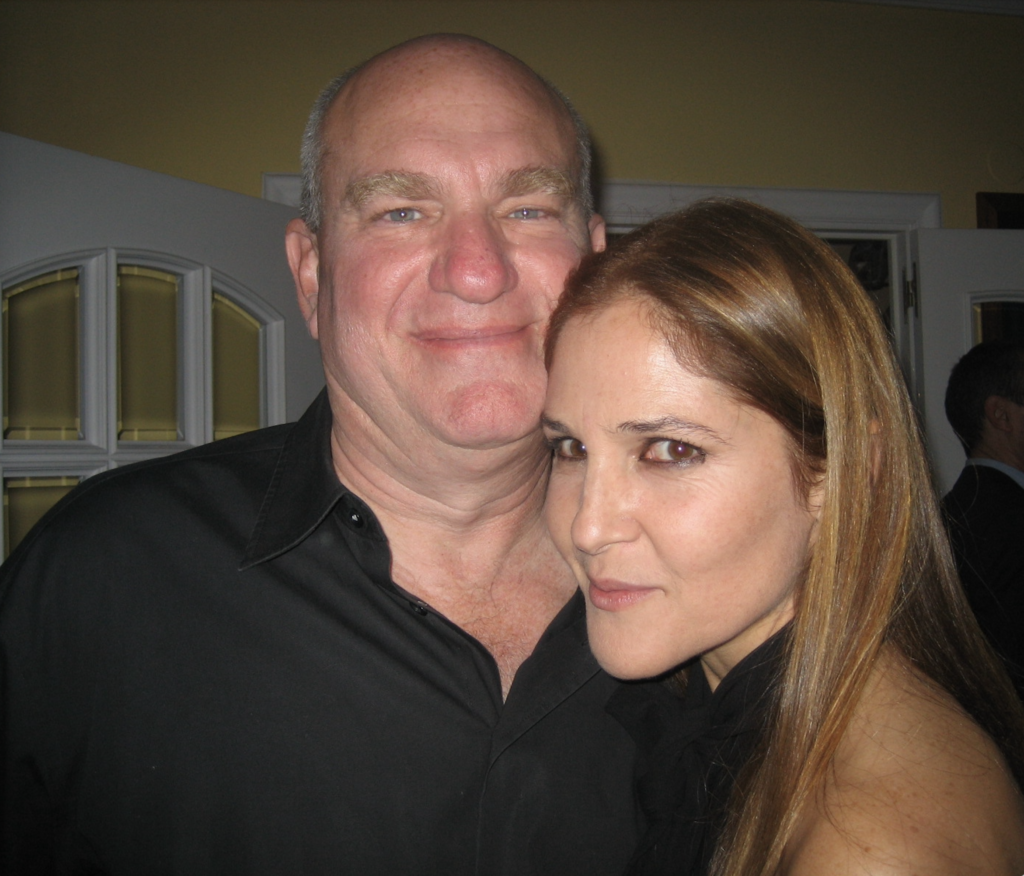
– You also told me that you have given some things to Dara, the trans model that appears on the cover of your book. Are you interested in the way she interprets your clothes?
When I met my cover model Dara Allen I fell in love! Her Instagram is better than a lot of magazines spreads! Dara is not only a superb and chic model, but also a photographer, stylist, art director and writer. She is engaged and very vocal about diversity, inclusion, identity etc. She is a unique and inspiring kid. She is unstoppable. Vogue USA recently ran a feature on her. Go Dara!
Dara is my creative outlet when it comes to clothes. I just sent her some beautiful pieces that I cannot fit into anymore and I have so much fun seeing how she puts them together, how she brings a new twist to them. For the next lot, I am eyeing two of my favorite dresses ever, both by Yamamoto. I will shed some tears when I finally part with them but they are quite sheer and totally inappropriate for my age. My consolation is that Dara will have so much fun with them. She will dance in them, party in them, flirt in them and style them in gorgeous selfies, so those two pieces will have a second very exciting life.
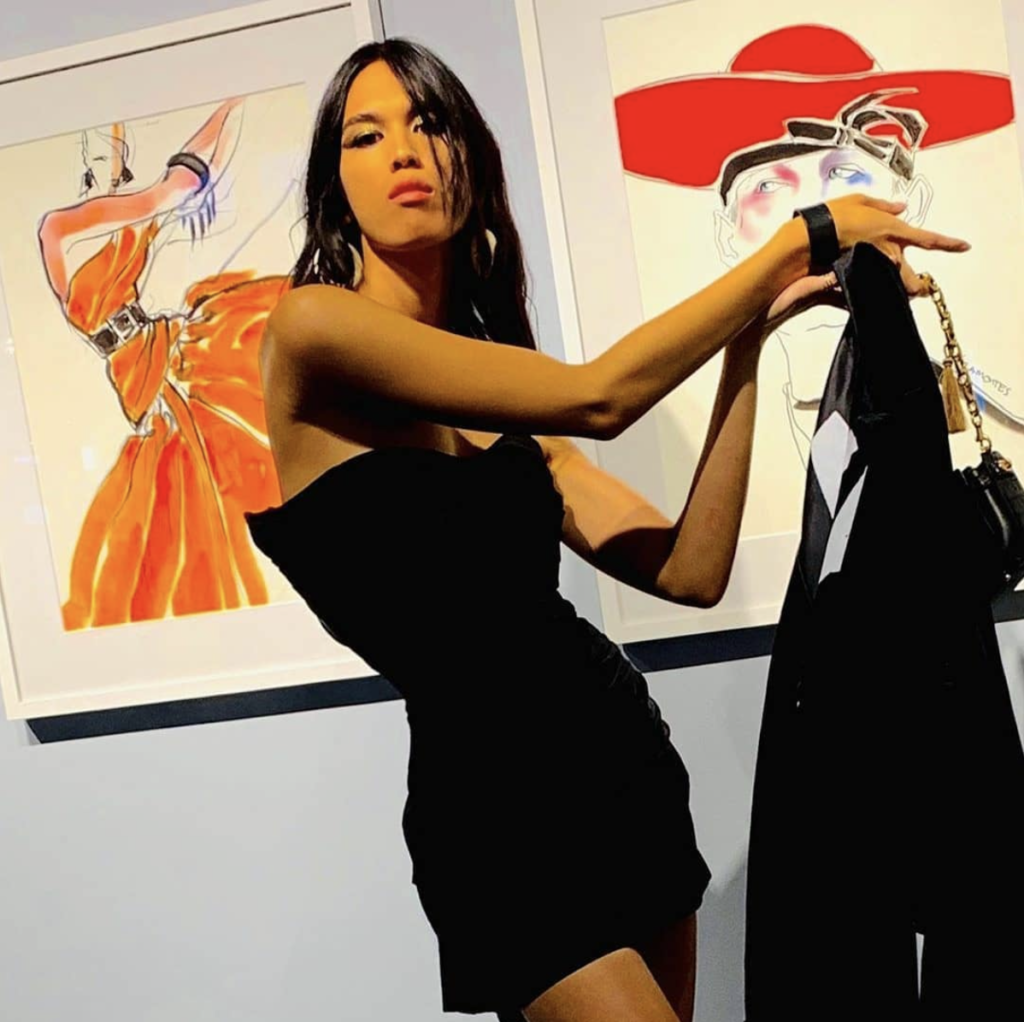
-How was the shooting of the cover?
Dara is part of a gang of very young and talented kids that gravitated towards the photographer Ethan James Green a few years ago. I met Ethan on a road trip in Mexico in 2015, he was a famous model who also took pictures and I was stunned by the beauty of his work and inspired in a way that I had not been in years. Ethan’s portraits were dignified, bare, raw, timeless, with no artifice. He had many portraits of beautiful young trans kids that blew my mind. These kids from every corner of America had gotten in touch with him over the course of a few years via their Tumblers and had created a sort of virtual artistic community around him. Eventually Ethan started meeting and photographing them: aspiring stylists, photographers, set designers, models… Dara Allen was one of those kids. Ethan was their mentor. They are all featured in Ethan’s stunning monograph Young New York.
On our road trip in Mexico we could not stop talking about my past in the fashion industry and the story I wanted to tell in Wildchilds. Back in new York and during get-togethers with Ethan and the kids, I began to believe in my love of fashion again, just looking at their faces and feeling their passion for the industry gave me the energy and inspiration that I needed to continue writing. I am so grateful to Ethan and the kids that I thank each one of them at the end of my novel. Even before I started writing Wildchilds, Ethan had become part of the creative process through the many chats I had with him about the actual state of the modeling and editorial industry. One day the conversation became about shooting my cover: the visual identity of Wildchilds…it was a given: Ethan had to shoot it.
I had never wanted to give a face to my characters Gus and Iris, I wanted non-identifiable models and I wanted a photograph, I did not want an illustration, which is so much the trend now in the literary industry and since I am self-published I got to control that. I sent Ethan a bunch of visual references: book covers from the 50’s French auteurs: graphic, bold and simple. He turned my concept down. Ethan said he wanted to shoot his muse Dara and a gorgeous friend of his with a great body called Fernando Cerezo III in a park on the Lower East side. I was like…. “Ummmmm…? Sure!” After listening to my stories about Tony Viramontes, Dara went on my fashionsphinx blog and researched every single image that Tony had done. Taking the one from the banner, the black and white shot of Tony drawing Leslie in a plume head-dress like a punk for British Vogue, Dara decided to do her own interpretation of it. Dara turned up on the shoot with this amazing coif of black feathers and a dress she made out of a pair of wide pants. She had strong makeup and sat on top of Fernando on the grass, a reverse and fierce version of Blow Out by Antonioni: girl on boy.
In an incredible twist of fate, Marc Jacobs used Tony Viramontes as inspiration for his A/W 2019 show and Dara walked the runway as a stylized and unrestrained Viramontes woman.
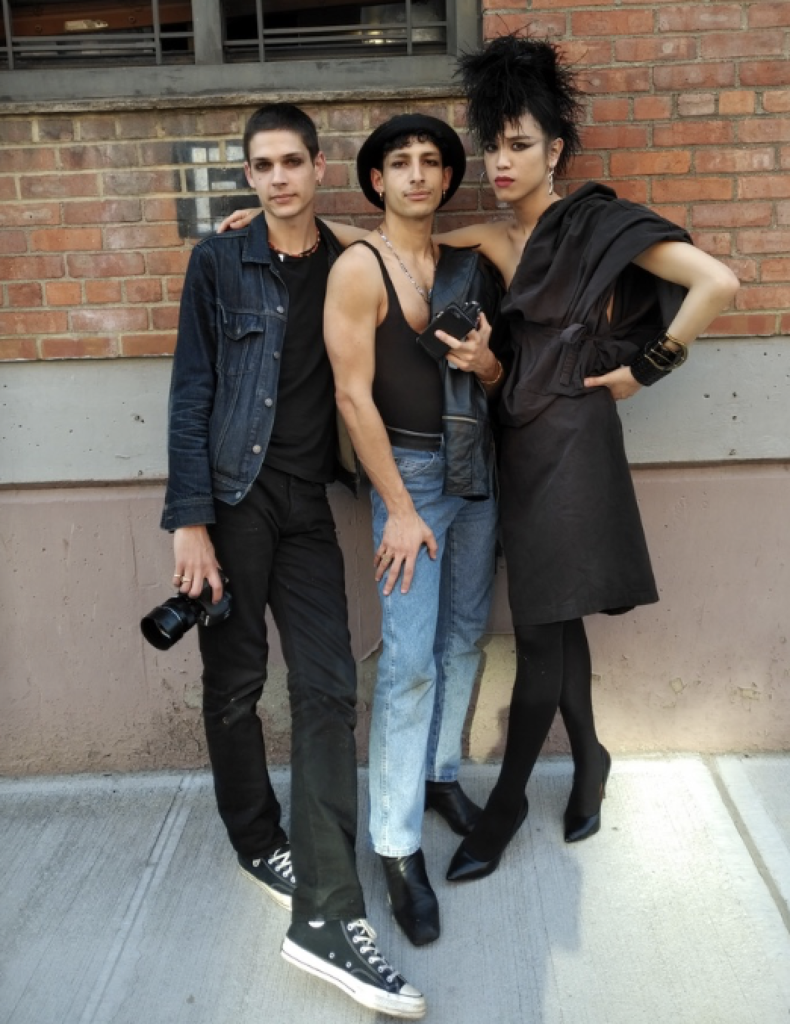
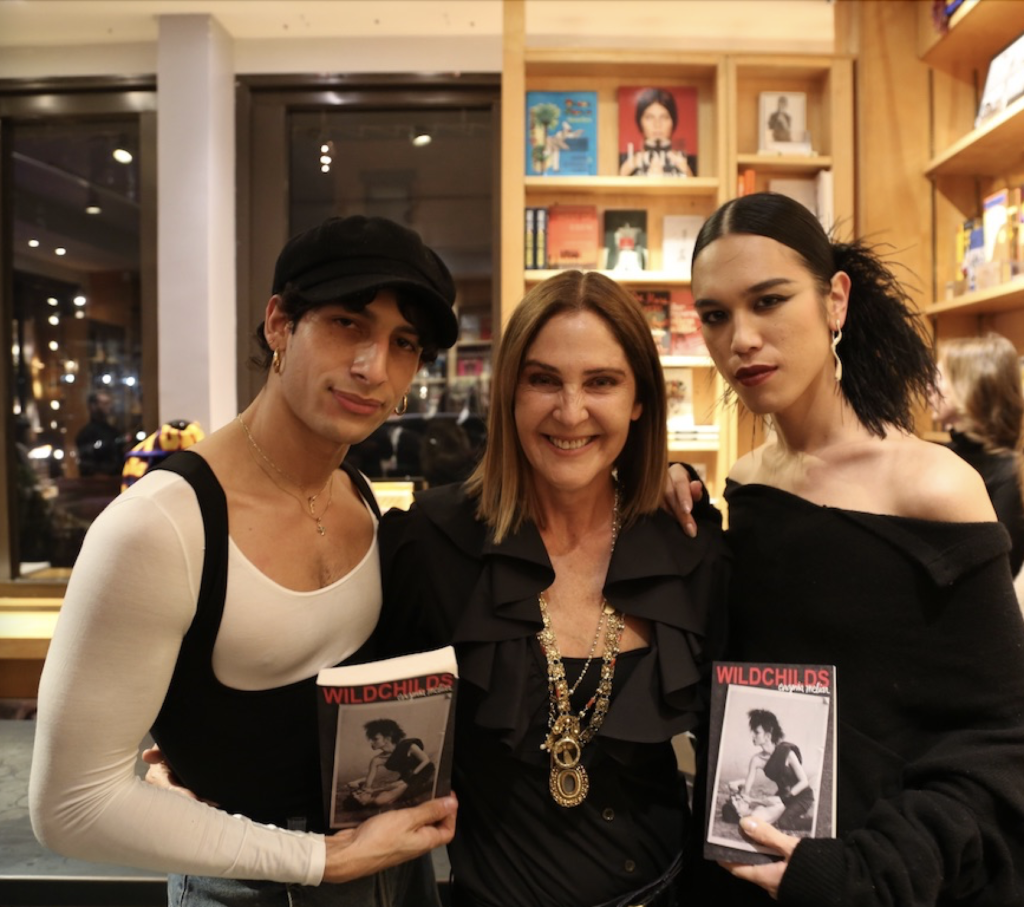
-Why did you ask Shawn Stüssy to design the cover?
I wanted that combination Ethan-Stüssy because their worlds and generations are so different. Shawn Stüssy is a dear friend of mine and the best graphic designer I know, I could not have dreamed of a better team. Shawn decided to give the cover a lo-fi feel, a patina, and designed a bold layout with a large font in cherry pink: some anarchy, some rebellion, intellectually challenging; everything that I love. My Wildchilds cover is a mood, a timeless depiction of an improvised creative moment: a photographer and his muse, or two lovers making art. Whichever way you look at it, the Wildchilds cover represents everything that I love about fashion and the special fashion moments I looked forward to living during my forty years career.
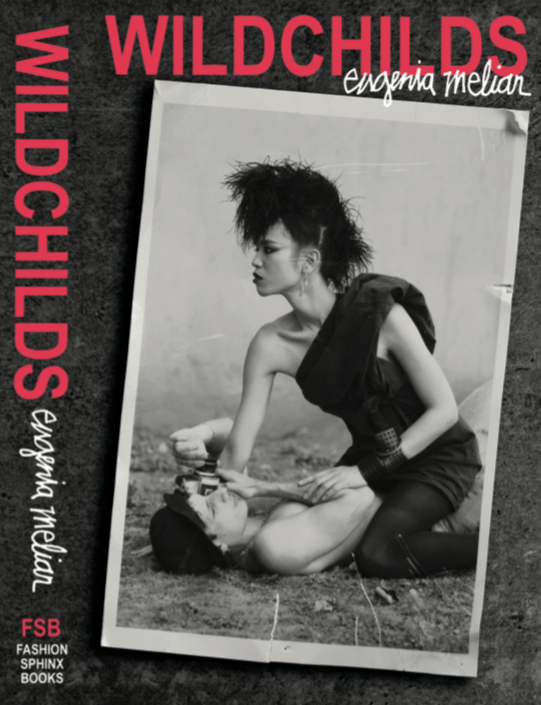
-What are you up to now?
The last two years have been complex. Because I am an independent author and I self-published my novel, I had to spend a lot of time learning about literary marketing in the digital age. A friend told me “writing a novel is the easy part, but selling it is hell.” I could not agree more. As an agent I knew how to sell my artists but now I have to sell myself, be on social media which I have always avoided, and then spend all my time pushing my work. It’s not inspiring and makes me quite depressed, but I am trying not to over-think it. This is the cost of freedom, of self-publishing a book and being totally responsible for its success or failure. In the end I am learning a lot about the industry and I am always happy when I learn a new skill.
Then Covid came.
After the first months of absolute shock and anxiety, worrying over my family and friends, as well as anyone who has lost their job and being locked down not able to see my siblings for over a year now, I realized that I had to get back to work, in spite of the fact that all book shops have been closed, and I cannot do any in-store or book clubs, so the promotion is all digital now.
I also have used the past months to learn how to write the Wildchilds TV pitch and I wil be sending it to production companies in the hope that a producer picks it up to make a TV series. When I was writing Wildchilds, I was picturing it on a screen, with spoken dialogs and real actors. It is a strange thing but it helped me visualize the world around it and how to bring it to life in a vivid way. I really think that it would make for a strong show. Fingers crossed.
-How is your next novel coming along? Does it anything to do with the fashion industry?
It’s about animals. No fashion in it at all.
I have had it in the back of my mind for so many years now, that it is flowing out steadily and pleasurably.
-Anything else that you are working on?
Yes: keeping sane and healthy and taking care of my boyfriend. Working in the garden, being in touch with my friends and observing this completely new world we will be living in; the changes have been so sudden, so fast, that it will take us a while to process. The way we study, work, eat, mingle, shop, watch movies, date, travel, do business, vacation, work out, celebrate…nothing is the same anymore, and this is the span of only twelve months…it’s insane. I am working on wrapping that around my brain and trying to adapt without feeling nostalgic for the world as it was before Covid.
©Eugenia Melian
March 2021
As narrated to Ana Domínguez Siemens.
